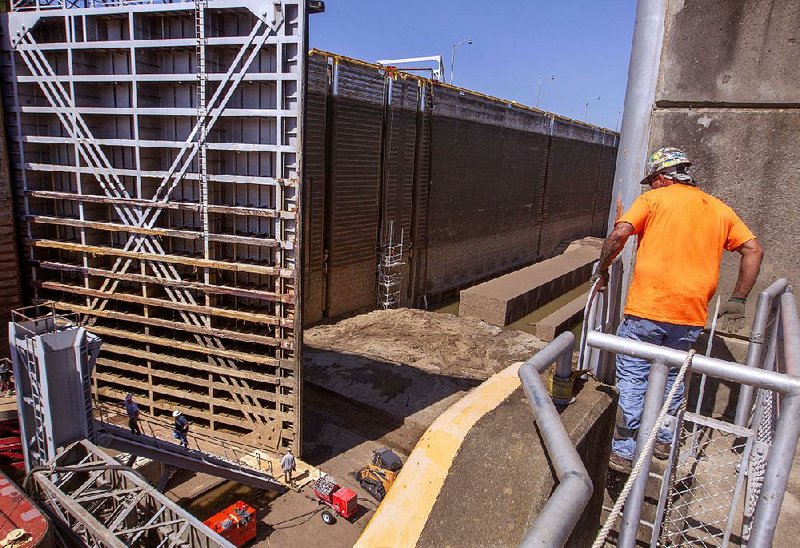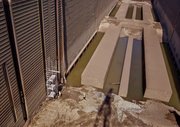In a rare appearance, the bedrock of the Arkansas River, 73-feet from the surface, was exposed Thursday when the U.S. Army Corps of Engineers drained the Dardanelle Lock and Dam No. 10.
The repair and maintenance project will take 14 days and about $600,000 to complete, said Laurie Driver, spokesman for the Corps of Engineers.
This is the fourth time -- including 1981, 1995 and 2012 -- in the lock and dam's 48-year history that it has been drained so experts could assess its interior.
The dewatering took a day and a half to empty 30 million gallons of river water -- think 600,000 baths, 45 Olympic-size swimming pools or 30 football fields covered in nearly 4 feet of water.
"They're like giant Lincoln Logs," Driver said as she pointed to two large temporary bulkheads stacked to hold back water from the now-dry lock.
A towering, 300-ton TomCat crane lifted materials from a docked river barge to the dry basin of the lock. Work crews erected scaffolding that will extend up to the top of the dam as they inspect each part of the dam's walls and channels.
Driver said the barges and tow boats that use the navigation channel were warned a year in advance of the project so alternate routes could be found during the maintenance session.
A lock and dam system enables large boats and barges to move from a level of water on a river to a higher or lower level by releasing or filling the channel with water. That constant movement of water can cause wear and tear on the structure. So every 10 or more years, the dewatering process exposes the internal components for closer inspection, maintenance and, if needed, repair.
Priorities and needed repairs were identified by engineers and Corps dive team members prior to the beginning of the project for the Dardanelle Lock and Dam -- the deepest of the lock chambers in the system. During the 12-hour-a-day shifts, workers will clean the downstream miter gate, replace bubbler lines, grease lines and broken timbers on a downstream miter gate, inspect and repair pintle bases, inspect all mission-critical components and perform an operational condition assessment of the lock components.
"We've got a great mission here and our workers are phenomenal," Driver said.
Project Manager Ashley Zink pointed to huge pieces of broken concrete slabs cordoned off with yellow caution tape.
"This was an unknown issue before we dewatered," she said. Lock and Dam operators began noticing a "lock boil" issue -- water turbulence -- but did not know the cause until the interior was exposed.
The 14 days that the lock is exposed will give the Corps team a good baseline on the lock and dam's condition, Zink said.
"If we expose a problem that's bigger than we can handle in the 14 days, we're prepared to expand the dewatering time," she said. "Otherwise, we will take a step back and plan for the future."
State Desk on 09/08/2017

